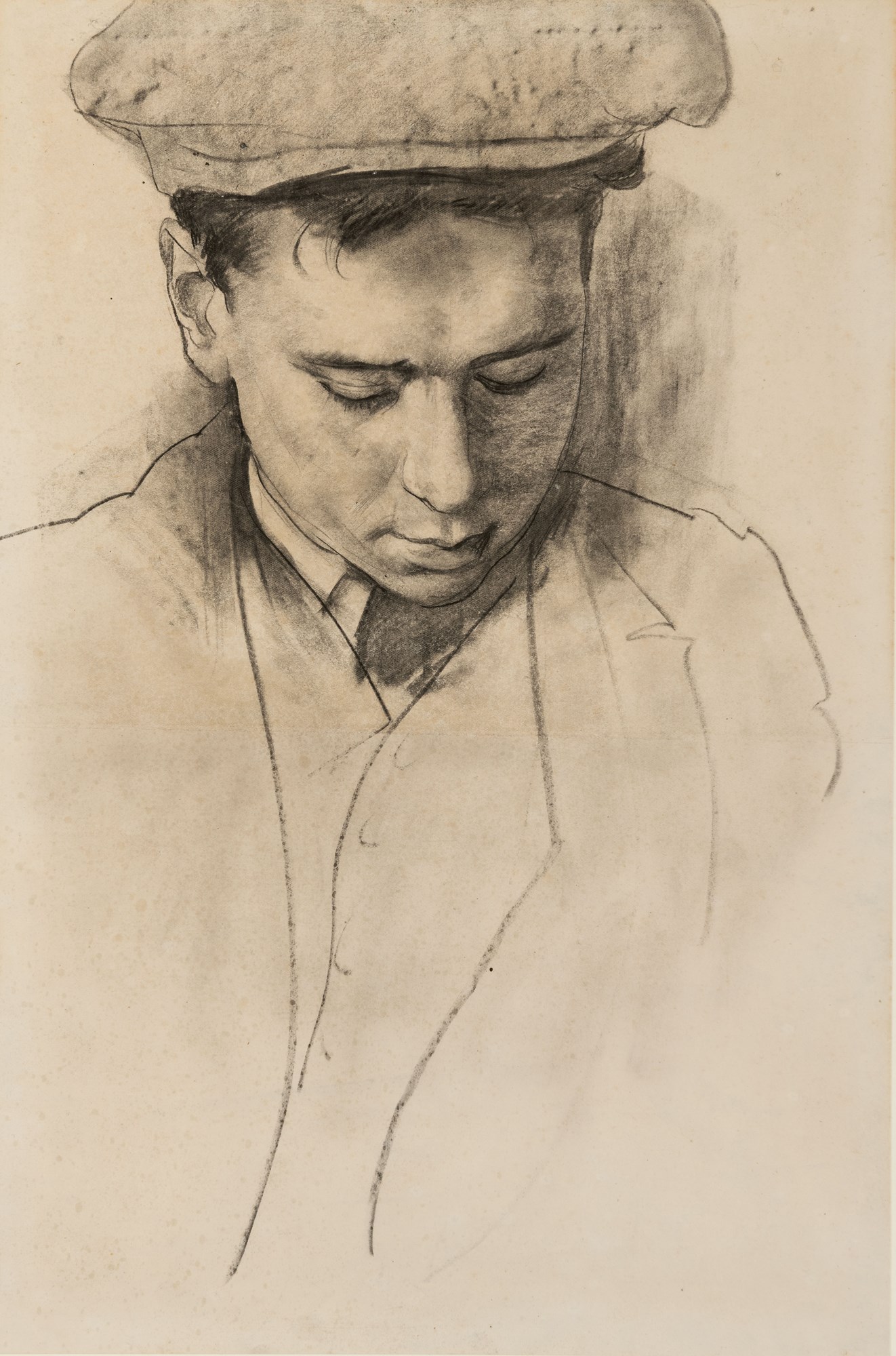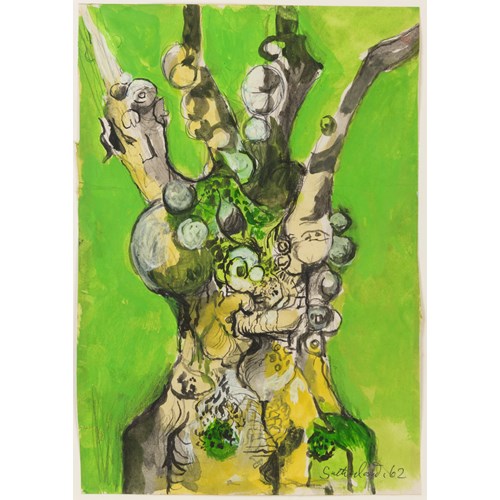Marketplace
Portrait Study of a Boy Wearing a Cloth Cap: Study for The Costardmongers
Eric KENNINGTON
Portrait Study of a Boy Wearing a Cloth Cap: Study for The Costardmongers
This large sheet is a study for the head of a young boy seated at the left of Eric Kennington’s first major canvas, The Costardmongers of 1914, today in collection of the Musée National d’Art Moderne at the Centre Pompidou in Paris. (The painting, which measures 132 x 122.3 cm., is currently on loan to the Musée d’Art et d’Industrie André Diligent – La Piscine in Roubaix.) The painting depicts costermongers – street sellers of fruit and vegetables working from stands or barrows, also known as costers or costards – in the Walham Green district of Fulham, and was the culmination of a series of paintings of London street life and vendors painted by Kennington in 1912 and 1913. As the Kennington scholar Jonathan Black has opined, ‘Kennington…set out to idealize his coster subjects because they were not ordinary working-class people who would have worked in a factory or within some other form of enclosed and strictly regulated environment. By painting them in the manner of the Northern or Italian Renaissance, Kennington has elevated these costers not only to make them worthy of a large canvas but also to locate them within a sort of elegy for a way of life. His costers occupy a niche of open-air working-class independence that seemed to be threatened by developments in modern urban life.’
When it was exhibited at the International Society of Sculptors, Painters and Gravers at the Grosvenor Gallery in London in April and May 1914, The Costardmongers was praised for its sympathetic treatment of working-class Londoners. As one contemporary critic noted, ‘There is strength of purpose, intensity of characterisation, with an almost pre-Raphaelite finish and downrightness, in Mr. Eric H. Kennington’s curiously hard yet, in its own way, very interesting group, “Costermongers”. The onlooker, rebelling at first, is in the end won over by the resoluteness and the sincerity of the artist.’ Another review of the Grosvenor Gallery exhibition praised the painting as ‘an extraordinary clever piece of work, vivid, without a patch of atmosphere, a personal vision…’, while yet another noted that ‘this larger composition quite establishes Mr. Kennington as one of the best painters who have appeared of late years…His costers are real live people in modern clothes, his accessories real bits of paper and pots and pans and other common objects of the lee-shore of a coster’s life - only he has composed them and coloured them as Van Eyck or Ouwater would have done.’
As Jonathan Black has noted elsewhere, ‘The Costardmongers was the first work Kennington exhibited which really made the critics sit up and take notice. He was described as a worthy successor to the mantle of Ford Madox Brown and as a draughtsman whose talent rivalled that of the far better known William Strang and William Orpen. Indeed, a number of influential critics identified him as by far the most promising among the younger generation of up and coming British artists.’ The sale of The Costardmongers to the portrait painter William Nicholson allowed Kennington to move to a studio on Kensington High Street in London. Two years later, in 1916, the large canvas entered the Musée du Luxembourg in Paris as the gift of Sir Edmund Davis, as part of a group of nearly forty British paintings and drawings from his collection, including works by Edward Burne-Jones, Frederick Cayley Robinson, William Holman Hunt, Augustus John, John Everett Millais, William Orpen, Glyn Philpot, Arthur Rackham, Walter Sickert, William Strang and George Frederic Watts.
A related charcoal full-length study for the figure of the same youth, with a large basket alongside him, is in the Kennington Family Collection, as is a very large charcoal drawing for the woman standing at the centre of the painted composition.
When it was exhibited at the International Society of Sculptors, Painters and Gravers at the Grosvenor Gallery in London in April and May 1914, The Costardmongers was praised for its sympathetic treatment of working-class Londoners. As one contemporary critic noted, ‘There is strength of purpose, intensity of characterisation, with an almost pre-Raphaelite finish and downrightness, in Mr. Eric H. Kennington’s curiously hard yet, in its own way, very interesting group, “Costermongers”. The onlooker, rebelling at first, is in the end won over by the resoluteness and the sincerity of the artist.’ Another review of the Grosvenor Gallery exhibition praised the painting as ‘an extraordinary clever piece of work, vivid, without a patch of atmosphere, a personal vision…’, while yet another noted that ‘this larger composition quite establishes Mr. Kennington as one of the best painters who have appeared of late years…His costers are real live people in modern clothes, his accessories real bits of paper and pots and pans and other common objects of the lee-shore of a coster’s life - only he has composed them and coloured them as Van Eyck or Ouwater would have done.’
As Jonathan Black has noted elsewhere, ‘The Costardmongers was the first work Kennington exhibited which really made the critics sit up and take notice. He was described as a worthy successor to the mantle of Ford Madox Brown and as a draughtsman whose talent rivalled that of the far better known William Strang and William Orpen. Indeed, a number of influential critics identified him as by far the most promising among the younger generation of up and coming British artists.’ The sale of The Costardmongers to the portrait painter William Nicholson allowed Kennington to move to a studio on Kensington High Street in London. Two years later, in 1916, the large canvas entered the Musée du Luxembourg in Paris as the gift of Sir Edmund Davis, as part of a group of nearly forty British paintings and drawings from his collection, including works by Edward Burne-Jones, Frederick Cayley Robinson, William Holman Hunt, Augustus John, John Everett Millais, William Orpen, Glyn Philpot, Arthur Rackham, Walter Sickert, William Strang and George Frederic Watts.
A related charcoal full-length study for the figure of the same youth, with a large basket alongside him, is in the Kennington Family Collection, as is a very large charcoal drawing for the woman standing at the centre of the painted composition.
Provenance: Maas Gallery, London in 1981
Private collection, London.
Literature: Rosemary Treble, ‘London. British Paintings 1837-1930’, The Burlington Magazine, June 1981, p.373, illustrated p.375, fig.4; Jonathan Black, The Face of Courage: Eric Kennington, Portraiture and The Second World War, exhibition catalogue, Hendon, 2011-2012, p.14, fig.4.
Exhibition: London, The Maas Gallery, Eric Kennington: An Exhibition of drawings, pastels and watercolours. 1905 to 1930, 1981, no.5.
Plus d'œuvres d'art de la Galerie




_T638638229729894607.jpg?width=500&height=500&mode=pad&scale=both&qlt=90&format=jpg)



_T638410372518782687.jpg?width=500&height=500&mode=pad&scale=both&qlt=90&format=jpg)
